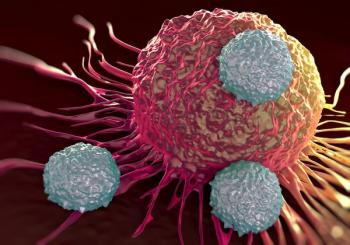
Oncology NEWS International
- Oncology NEWS International Vol 11 No 5
- Volume 11
- Issue 5
Patients’ Subjective Fatigue Assessments Help Guide Anemia Management
HOUSTON-Using subjective complaints reported by patients as a basis for treatment is new, "in a sense revolutionary," said Charles S. Cleeland, PhD, and worth pursuing. Well-established pain measurement scales can be used as a model to assess multiple symptoms, including fatigue, among cancer patients and identify moderate to severe levels of symptoms that might warrant intervention, he explained. Dr. Cleeland is McCullough Professor of Cancer Research at the University of Texas M.D. Anderson Cancer Center in Houston.
HOUSTONUsing subjective complaints reported by patients as a basis for treatment is new, "in a sense revolutionary," said Charles S. Cleeland, PhD, and worth pursuing. Well-established pain measurement scales can be used as a model to assess multiple symptoms, including fatigue, among cancer patients and identify moderate to severe levels of symptoms that might warrant intervention, he explained. Dr. Cleeland is McCullough Professor of Cancer Research at the University of Texas M.D. Anderson Cancer Center in Houston.
"Fatigue nests within a much larger set of cancer-related symptoms," he said. "These symptoms are present not only for weeks but often months," and "many symptoms such as fatigue persist dramatically after therapy."
Dr. Cleeland introduced the concept of "symptom burden," although he did not coin the term. Symptom burden is defined as "the combined impact of all the symptoms (related to disease or therapy) on the ability of persons to function as they did prior to the onset of the disease and/or therapy."
What’s Driving Demand?
"We’re in an era where there is an increasing demand for better symptom control," Dr. Cleeland said. Media coverage has increased awareness of symptom control and "more knowledgeable and demanding consumers are asking for broad symptom control, and specifically for fatigue."
The federal government also promotes the concept. Just last year, the Institute of Medicine called for quality of life and symptom control to be high priority issues. Dr. Cleeland acknowledged the public policy aspects of symptom control. "The cost of treatment for the symptom must be balanced by improved function and comfort and be supported by those who pay for such treatments," he noted (see Table 1).
Pain as a Model
To justify treating symptom burden, "symptom severity certainly has to be at a level to impair function," he said. There also needs to be a clear relationship between the symptoms and the proposed treatment. "That is, we have to have a potential relief or cure for that symptom."
Pain can be used as a model for treating symptom burden. Pain has a well established impact on quality of life and effective treatments with acceptable side effects are available. Pain control is valued by patients, health professionals, and others. "And finally, pain among all the symptoms that constitute symptom burden is the first to actually have some standard for its care suggested by JCAHO.
The Brief Pain Inventory was developed by the Pain Research Group and measures components of pain, including intensity and interference with activities, on a scale of 0 (no pain) to 10. Use of this inventory by cancer patients has shown a pattern, an "increasing staircase of impairment," starting between levels 5 and 6, "which does have implications for when we treat and how aggressively we treat pain," Dr. Cleeland said.
A study of 2,000 patients from four countries, identified "very tight groupings of pain: 1 to 4 was mild, 5 to 6 was moderate, and patients who had pain of 7 or greater really had very, very severe pain," Dr. Cleeland explained. "What we’ve seen now is that pain is becoming accepted as a metric, as a measure." For example, the National Comprehensive Cancer Network (NCCN) guidelines define scores of 7 to 10 as "a pain emergency," he said.
Adapting Model to Fatigue
Can the pain model be adapted to fatigue? NCCN guidelines define cancer-related fatigue as "an unusual, persistent, subjective sense of tiredness related to cancer or cancer treatment that interferes with usual functioning." So persistence, severity, and interference with functioning could be used as reference points.
A review of studies using different fatigue scales shows them to be highly correlated and patients’ ratings show a somewhat similar staircase of impairment. Patients rating fatigue as 1 to 4 report little impairment. The level of impairment picks up at 5 and 6 and is severe at level 7. In a cross-sectional study, 50% of patients with hematologic malignances had fatigues scores of 7 to 10, compared to 16% in the community control.
Several studies have reported significant improvement in multiple symptoms associated with increases in hemoglobin, including a decrease in fatigue. This is borne out by an M.D. Anderson study that found an almost linear relationship between fatigue reported by cancer patients and their and hemoglobin levels (see Figure 1, above).
Articles in this issue
over 23 years ago
Prognosis Good for Local Recurrence After Lumpectomyover 23 years ago
Long-Term Use of Actiq Safe and Effective for Breakthrough Painover 23 years ago
Youth Exposed to Tobacco Promotionsover 23 years ago
Green Tea May Help Prevent Certain Gastrointestinal Cancersover 23 years ago
EGFR Inhibitor Effective as Salvage Therapy for NSCLCover 23 years ago
Targeted Filgrastim Support Allows Planned Chemotherapy Dosesover 23 years ago
Low Risk of CHF With Paclitaxel/Trastuzumab Adjuvant Rxover 23 years ago
Anxiety, Depression in Women at High Risk for Breast Cancerover 23 years ago
NCCN Updates its Treatment Guidelines for Breast Cancerover 23 years ago
Danny Glover ‘Acting’ as Spokesman for Anemia LifeLineNewsletter
Stay up to date on recent advances in the multidisciplinary approach to cancer.

















































































